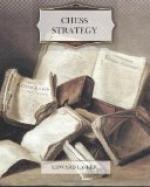If White plays 5. P-QKt3 before castling, Black exchanges pawns and checks with the Queen. Now White has the disagreeable choice between B-Q2 and P-B3. The former must be bad, being contrary to the plan of development as intended by P-QKt3. The latter blocks the very diagonal on which the Bishop was meant to operate. White can open up the diagonal by playing P-QB4 after castling, nor would it really imply the loss of a move to have played the BP twice, since Black must move his Queen again from R4, where she has no future. But in any case there remains the disadvantage that White was forced to play the BP, whilst before he had the option of withholding its advance until a more opportune moment.
Another possible subtlety in Black’s sequence of developing moves would be to withhold the advance of his KP until White has played P-QKt3, and then to play the QB to Kt5. For, as I have already remarked, the objection to developing Black’s Queen’s Bishop lies in White’s threat to attack Black’s QKtP with Q-Kt3. That possibility disappears after P-QKt3.
Before bringing the discussion of the Queen’s Pawn opening to a close, I may remark that in tournaments it has become usual for White not to play P-QB4 at once, but to play Kt-KB3 as a preliminary, in order to avoid the complications of the Queen’s counter gambit: 2. P-QB4, P-K4.
If White plays 3. PxKP, Black’s reply is P-Q5, and the obvious move 4. P-K3 fails on account of the following pretty combination: B—Kt5ch; 5. B—Q2, PxP; 6. BxB, PxPch; 7. K-K2, PxKtch!!; 8. RxKt, B-Kt5ch, etc.
Instead of 4. P-K3, White should play P-KKt3 and develop his KB at Kt2. Black could now try to regain his pawn with Kt-K2-Kt3, but he can also sacrifice a pawn by P-KB3, with a view to rapid development.
It now only remains for us to discover whether Black has any other answer to P-Q4 which would necessitate close analysis on White’s part.
Here must be mentioned: 1. ... Kt-KB3, 1. ... P-QB4, and 1. ... P-KB4. The former move prepares P-Q3, followed by P-K4. In this opening there is no reason why White should play P-QB4, as there is no prospect of opening the QB file for the Rooks. Furthermore, Black has relinquished the square Q4 and made K4 the basis of operations. It will be more advisable to prevent Black from playing P-K4 as far as this can be achieved in conformity with a logical development, e.g. 1. P-Q4, Kt-KB3; 2. Kt-KB3. Not 2. Kt-QB3, because Black could then lead into the Queen’s gambit by playing P-Q4 and P-QB4, after which White has the disadvantage of not being able to open the QB file. 2. ... P-Q3; 3. B-B4, QKt-Q2; 4. P-K3. Now Black can only enforce P-K4 after P-B3 and QB2. Meanwhile White mobilises all his pieces, whilst Black’s QB remains blocked and the Kt must remain at Q2 to cover the KP. If, on the other hand, Black exchanges pawns in order to free the Knight, there is no Black centre left.




